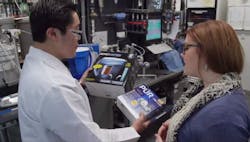How NSF tests for lead in drinking water
ANN ARBOR, MI., JUNE 28, 2016 -- Lead in drinking water has evolved into a nationwide concern. Lead can come from decaying infrastructure underground and fixtures in your home. NSF International is a public health and safety organization which has led development of standards governing water quality. In 1990, the U.S. Environmental Protection Agency replaced its own drinking water standards with a water advisory program that includes these NSF/ANSI standards. NSF certifies water treatment and filtration systems to these standards. If you are concerned about lead in your drinking water, NSF International has educational resources, guides and tips.
1. Determine if there are lead levels in your local water
If you get your water from a public water utility in the United States, the U.S. Environmental Protection Agency (EPA) requires that it is tested and a report is sent to citizens. This Consumer Confidence Report is released in June or July each year and explains what your public water system was tested for. NSF has a web page that explains how to read it: Understanding Consumer Confidence Reports, at http://www.nsf.org/consumer-resources/health-and-safety-tips/water-quality-treatment-tips/consumer-confidence-reports.
2. Determine if there are lead levels in your home's water
If you have an older home, you could have a lead service line or plumbing fixtures inside your house that are leaching lead into your water. Learn more about these sources of Lead in Your Drinking Water. You can also take steps at home to reduce the risk of exposure. See NSF's tips about Older Homes and Lead in Water, at http://www.nsf.org/consumer-resources/what-is-nsf-certification/faucets-plumbing-certification/special-note-about-lead.
The EPA also has a guide to Identifying Lead-free Certification Marks on Plumbing Products, at http://www.nsf.org/newsroom/identifying-lead-free-certification-marks-on-plumbing-products-1, which can help you assess the risk of lead contaminants based on the pipes installed in your home.
Test Your Water
If you suspect you have lead in your water, start by having your water tested at a certified laboratory. This is necessary because you can't see, taste or smell lead dissolved in water. A list is available from your state environmental quality department or your water municipality (where you pay your water bill). NSF International also has a Water Testing Guide to help you find a laboratory for testing.
3. Find water filtration and treatment products that reduce lead
If you have lead in your drinking water or are just concerned, many water filters and treatment systems are designed reduce lead in drinking water. NSF International's Contaminant Reduction Claims Page explains which products reduce lead and provides a link to the list of NSF certified products that reduce lead in drinking water.
Look for one of two standards and lead reduction claims
Products that are designed to reduce lead in drinking water should be certified to one of two NSF standards: NSF/ANSI 53 for drinking water filtration products or NSF/ANSI 58 for reverse osmosis systems. Because these standards certify products to reduce a variety of contaminants, not only lead, it's important to check the packaging for both NSF/ANSI 53 or NSF/ANSI 58 AND a claim for lead reduction. Still unsure? Contact us at 1.800.673.8010, email us at [email protected] or check the listings page in Step 4.
Remember to change your water filters
Your filter's ability to reduce lead is tied to the amount of water that flows through it. To ensure your water filter performs effectively, use the proper replacement cartridge and change your filter when the manufacturer recommends it.
4. Learn more about testing and certification
NSF's Consumer Guide – NSF Certified Product Listings for Lead Reduction details how we test and certify water filters to reduce lead. It also provides information about several different types of water filters we have certified to reduce lead in drinking water.
How filters work to reduce lead in your water
Filters are designed with pores that trap contaminants mechanically. Water passes through the filter pores, leaving lead behind. Other contaminants adhere to the surface of the filter media, which is typically carbon, charcoal or a blend of filter media. Eventually the surface area of the filter media becomes filled and no more contaminants can be adsorbed. Also, the pores of the filter become clogged, preventing water from moving through effectively. This is why changing the filter is important.
5. If you can't get a filter right away, use NSF certified bottled water
If you discover lead in your drinking water, it may take time to address the problem. To avoid drinking untreated tap water, bottled water is a reliable backup. Bottled water certified by NSF International has undergone microbiological, chemical and radiological tests to assure it meets international regulations such as WHO, FDA, EPA, EU and DIN EN ISO.
About NSF International
NSF International is an independent global organization that writes standards, and tests and certifies products for the food, drinking water, health sciences and consumer goods industries to minimize adverse health effects and protect the environment (nsf.org). Founded in 1944, NSF is committed to protecting human health and safety worldwide. Operating in more than 165 countries, NSF International is accredited by the American National Standards Institute (ANSI) and is a Pan American Health Organization/World Health Organization Collaborating Center on Food Safety, Water Quality and Indoor Environment.
SOURCE: NSF International
